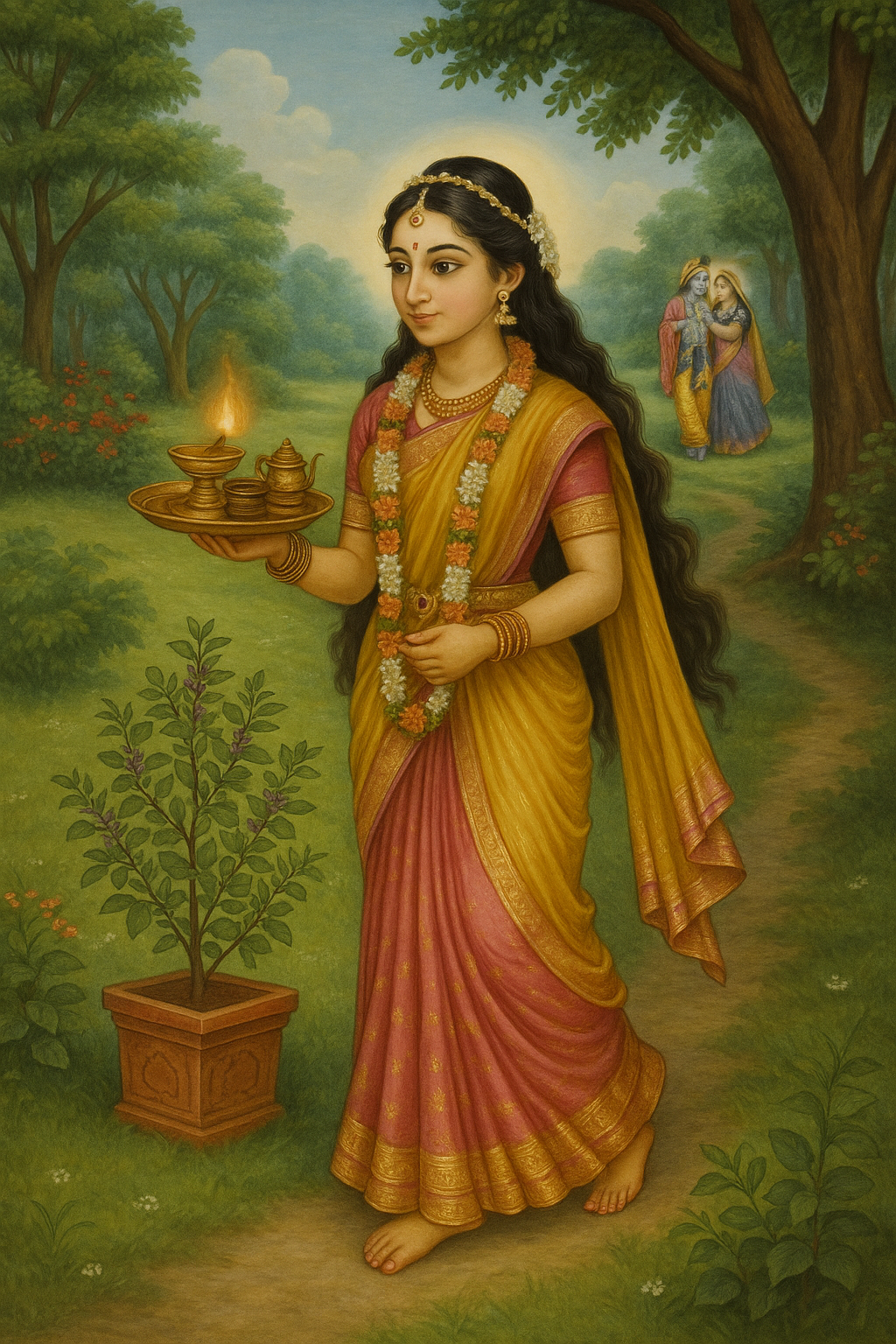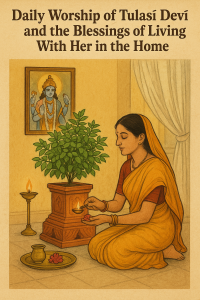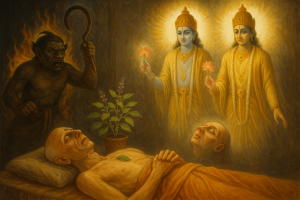Beyond the Earthly Form
Though she appears in this world as a sacred plant, Tulasī Devī is an eternal associate of Śrī Kṛṣṇa. In the highest spiritual realm of Goloka Vṛndāvana, she manifests in her original form as a beautiful, devoted gopī—fully engaged in the loving pastimes of Rādhā and Kṛṣṇa.
She is not different from her earthly form; rather, her plant body is a merciful manifestation, descending into this world to uplift fallen souls and guide them back to Kṛṣṇa’s lotus feet.
The Padma Purāṇa and other Vaiṣṇava scriptures affirm that Tulasī is a spiritual personality, and her presence as a plant is only to facilitate the bhakti of the conditioned living beings.
Her Role in Kṛṣṇa’s Pastimes
In the spiritual world, Tulasī serves Śrīmatī Rādhārāṇī, arranging meetings between Rādhā and Kṛṣṇa, decorating the groves of Vṛndāvana, and preparing the kuñjas for Their secret rāsa-līlās.
She acts with perfect chastity, surrender, and prema, and the gopīs honor her for her tireless service and devotion. She is not counted among the aṣṭa-sakhīs or principal gopīs, but her service is intimate and indispensable.
In Vṛndāvana, Tulasī is described as walking gracefully, dressed in radiant silks, garlanded with forest flowers, and carrying incense, lamps, and auspicious items to prepare the paths for Śrī Rādhā and Śrī Kṛṣṇa.
Her Spiritual Status
Tulasī is counted among the nitya-siddha associates of the Lord—those who are eternally perfect and never touched by material illusion. Unlike conditioned souls, she never forgets the Lord or turns away from Him.
She is a vaiṣṇavī-devī, a guardian of bhakti-mārga, and a messenger of divine love. Even the greatest yogīs and demigods seek her mercy, for she grants entrance to the confidential service of the Divine Couple.
Her name, Vrindā-devī, is often mentioned in Vraja literature, and in many texts, Tulasī and Vrindā are considered one and the same, or closely related in function and devotion.
Thus, to worship Tulasī is not just to water a plant—it is to honor an eternal Vraja-gopī, who lovingly beckons us into the eternal līlā of Śrī Kṛṣṇa.
Lessons to Be Learned
1. Tulasī Devī Is a Divine Personality, Not a Symbol
Śrīla Prabhupāda firmly established that Tulasī is not an ordinary plant or a mere symbol of piety—she is a devotee, a servant, and a friend of the Lord. She is to be worshiped, prayed to, and respected as an eternal associate of Kṛṣṇa.
2. All Devotional Service Should Be Offered Through the Vaiṣṇavas
Just as one must approach Kṛṣṇa through His devotees, we must approach Vṛndāvana and the Lord’s pastimes through Tulasī Devī’s mercy. She represents the pathway of service, and without her blessings, entrance into divine love is impossible.
“Without the mercy of the devotee, one cannot attain the Lord.” – Śrī Caitanya-caritāmṛta
3. Even the Smallest Seva Pleases the Highest
In her spiritual form, Tulasī performs humble services—decorating paths, lighting lamps, arranging kuñjas. Yet these acts are most dear to the Lord. This shows us that there is no small service in bhakti—only sincerity and love matter.
4. We Are Meant to Follow in Her Footsteps
Tulasī’s life, whether in plant form or as a gopī, is one of complete surrender. Her purity, steadiness, and enthusiasm are ideal for all sādhakas. If we can emulate her mood even slightly, we will find ourselves progressing steadily on the path of prema.
5. Tulasī Connects Us to Goloka
She stands as a bridge between the material and spiritual worlds. By daily worshiping her, circumambulating her, and serving her with reverence, we become connected to Goloka Vṛndāvana—to the confidential pastimes of the Lord.



